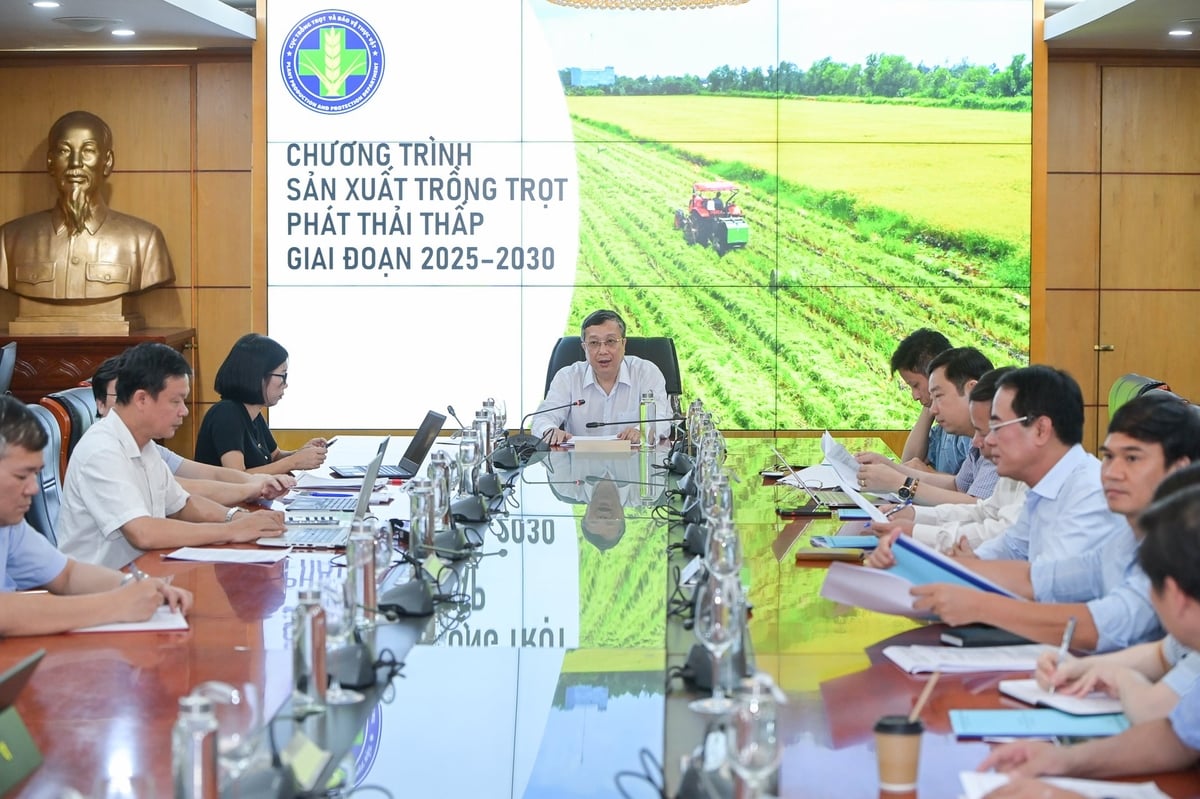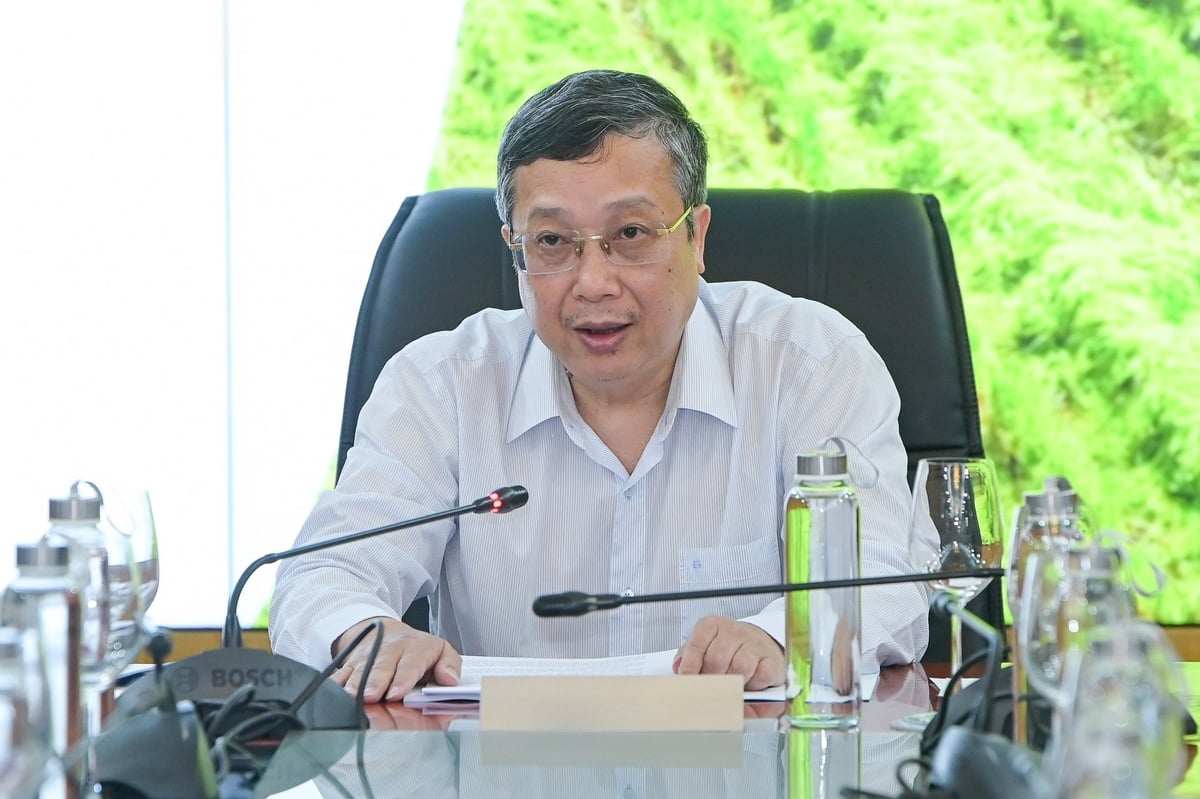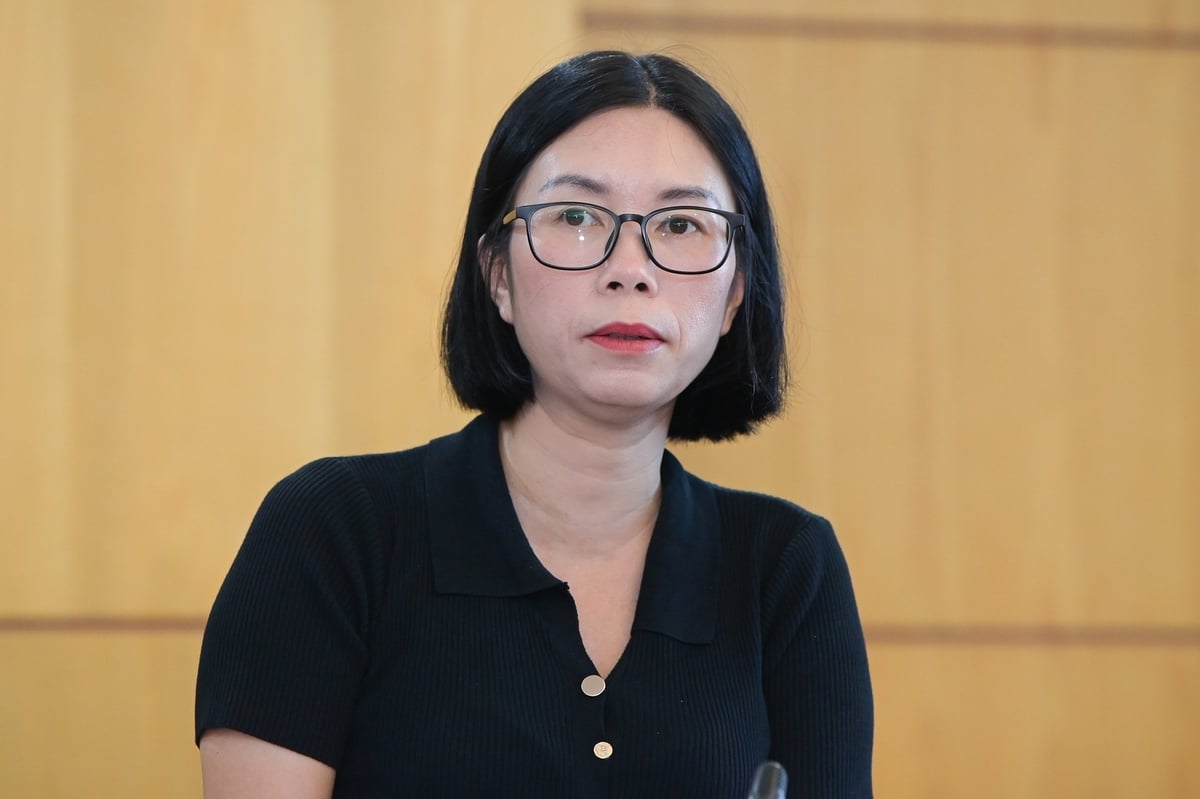December 17, 2025 | 01:03 GMT +7
December 17, 2025 | 01:03 GMT +7
Hotline: 0913.378.918
December 17, 2025 | 01:03 GMT +7
Hotline: 0913.378.918
On the morning of June 26, Deputy Minister of Agriculture and Environment Hoang Trung chaired a working session with the Plant Production and Protection Department and other relevant units under the Ministry to discuss the development of a low-emission crop production scheme for the 2025-2030 period.
This scheme will serve as a guideline for central and local agencies to implement, with low-emission cultivation practices and measurement tools being key components in the development of the low-emission crop production plan.

Deputy Minister Hoang Trung worked with units from the Ministry of Agriculture and the Environment on the issue of emission reduction in crop production. Photo: Tung Dinh.
According to the Deputy Minister, low-emission crop production is part of the nation’s overall strategy to achieve net-zero emissions by 2050. However, in this sector, efforts have so far been limited to a few small-scale projects and programs without a comprehensive, systematic approach.
“We need to develop a well-structured scheme that can be smoothly implemented from the Ministry down to the local levels,” Deputy Minister Hoang Trung stated.
He noted that currently, only the One Million Hectares of High-quality, Low-emission rice project in the Mekong Delta has been approved and implemented. However, the country has more than 7 million hectares of rice and over 1 million hectares of fruit trees nationwide, so the Crop Production and Plant Protection Department needs to draft the proposal soon, collect feedback, and finalize it for the earliest possible implementation.

Deputy Minister Hoang Trung emphasized the issue of measurement tools and cultivation processes. Photo: Tung Dinh.
Regarding the details, the leadership of the Ministry of Agriculture and Environment pointed out that current obstacles to emission reduction in crop production include the lack of a legal framework, absence of measurement tools, and limited awareness among the majority of people, businesses, and local officials about low-emission crop production.
On the directive perspective, the Deputy Minister emphasized: “Low-emission crop production must aim to fulfill obligations related to the NDC and change cultivation practices towards reduced input use, sustainability, and environmental friendliness. It should also build a low-emission agricultural brand to promote the crop production sector's responsibility towards the environment and future generations.”
From a technical standpoint, Deputy Minister Hoang Trung requested the Plant Production and Protection Department to supplement research and develop emission-reducing cultivation procedures tailored to each crop type and ecological region. This would establish internationally recognized, scientifically based MRV methods. Subsequently, these would be formalized through legal documents for deployment to localities, serving as a basis for calculating emissions at each stage of production.
“Many objects in the cultivation industry, especially perennial fruit trees and industrial crops, have the ability to absorb CO2, so it is necessary to calculate the difference between emissions and absorption, and determine emissions at each stage. From there, suitable and effective production processes can be developed,” emphasized Mr. Hoang Trung.
Accordingly, changing cultivation practices and reducing input materials will be the key to lowering emissions in crop production. Regarding the roadmap, the Deputy Minister suggested focusing on several main crops, particularly rice, and implementing them thoroughly before expanding to other crops.
At the working session, Ms. Nguyen Thi Thu Huong, Deputy Director of the Plant Production and Protection Department, presented some draft scheme targets.
Among these, the goal is to reduce total methane (CH4) emissions by 30% and cut at least 10% of total greenhouse gas emissions from the crop production sector by 2030 compared to the 2020 baseline. This will be achieved through the application of technical measures suitable for each ecological region and crop group.
By 2030, the area applying low-emission crop production practices is expected to reach at least 2.5 million hectares, prioritizing concentrated commercial production zones.
A greenhouse gas emissions database for crop production will be established, categorized by crop type, ecological region, and technical measures, contributing to the formation of a carbon market.
A system of communication materials will be developed to disseminate knowledge and promote behavioral change among farmers towards low-emission production. Training and workshops on techniques, policies, and emission measurement tools will be organized nationwide for technical staff, agricultural extension officers, and farmers.

Ms. Nguyen Thi Thu Huong, Deputy Director of the Plant Production and Protection Department, presented the draft of the proposal. Photo: Tung Dinh.
Currently, the Plant Production and Protection Department is gathering feedback regarding the target crops for application and the implementation roadmap of the scheme.
On this matter, Professor Dr. Nguyen Hong Son, Director of the Vietnam Academy of Agricultural Sciences (VAAS), emphasized the need for specific assessments of the absorption/emission capacities of different crop types to make appropriate choices.
For example, comparing short-term crops with perennial crops, wetland crops with upland crops, or evaluating based on total cultivated area and fertilizer usage volume.
Regarding cultivation practices, Mr. Nguyen Hong Son suggested that each measure should be considered for application in specific regions and crops, avoiding blanket implementation that may be ineffective: “For instance, where should alternate wetting and drying irrigation be applied?”
In addition to VAAS leadership, participants at the working session also raised opinions about utilizing agricultural residues, producing simple types of biochar with moderate requirements.
Moreover, there is a need to build a system for monitoring, updating, and evaluating the effectiveness of each crop season and year to provide timely guidance and adjustments.
Changing awareness, enhancing efficiency
Regarding implementation, Deputy Minister Hoang Trung emphasized the need to clarify that Vietnam has been producing crops with a low-emission approach. From there, communication efforts should be strengthened to raise public awareness about this policy.
“Participating in low-emission production is not only a contribution of the people to the national NDC responsibilities but also helps build the brand of Vietnamese agricultural products and reduce input costs, thereby enhancing economic efficiency,” affirmed the Ministry of Agriculture and Environment leader.
He noted that when both management agencies and farmers achieve emission reduction targets in crop production, it will attract more attention, participation, and resources from international organizations.
The nationally determined contribution (NDC) refers to the commitments made by a country to address climate change, including targets for adaptation and greenhouse gas emission reduction, policies and measures to respond to climate change in order to meet the goals of the Paris Agreement.
Translated by Phuong Linh

(VAN) UNICEF and IOM receive this aid and provide essential services to assist families affected by recent storms and floods.

(VAN) Circular economy is regarded as a suitable pathway for Viet Nam’s fisheries sector, helping to improve production efficiency, optimize resources, and reduce environmental pressure.

(VAN) Vietnam and the UK are promoting cooperation in agriculture, environment, renewable energy, and green transition, with the goal of achieving Net Zero.

(VAN) Switzerland highly values carbon credit cooperation potential with Viet Nam and hopes to begin negotiations under Article 6 of the Paris Agreement.

(VAN) Northwestern women not only preserve traditional weaving but also leverage their cultural identity to create livelihoods, while spreading it to tourists through authentic experiences.

(VAN) Based on research results and production practices, the international scientific community evaluates UNI 126 as one of the world's best Panama disease-resistant banana varieties.

(VAN) More than 10,000 hectares of Cavendish bananas (Philippines), once abandoned due to the Panama Fusarium wilt Tropical Race 4 (TR4) disease, have now been brought back into production by switching to the Formosana variety.